
Photography by Chris Rose
“Bilge pump” is not a standard switch in most aircraft, but it is in a Searey two-seater that can retract its gear and float like a boat—or lower it to crawl out of the water on its belly like a reptile. More than 500 pilots have spent about 800 hours each assembling the Searey as a kit since 1992, but approval as a Light Sport aircraft (LSA) in November 2012 means the Searey LSA Sport is available factory-built for those who wouldn’t trust themselves to change a toilet flapper, let alone build an airplane. Fifteen Searey LSA models are on order at Progressive Aerodyne in Tavares, Florida, America’s “Seaplane City.”
First, a disclosure. Prior to takeoff from Avon Park, Florida, on our photo formation flight for this article, I told lead pilot Phil Jimenez of P.J. Aircraft that the best formation speed for the Searey LSA Sport ($125,000) equipped with the 100-horsepower Rotax 912 ULS engine was 70 knots. He preferred not to fly that slowly in his Cessna 172, and since CEO Adam Yang of Progressive Aerodyne had arrived with four Seareys, I opted for a kitbuilt Searey equipped with the 115-horsepower turbocharged Rotax 914 UL; it has a seven-mph speed advantage over the Sport. It is identical to the Searey LSA Elite model ($144,000) with the Rotax 914 UL and a carbon fiber hull. (The Sport comes standard with a fiberglas hull, but carbon fiber is an option.) The Elite model was still pending LSA approval as this was written, so you’re getting an advance look at the more powerful LSA model. Photographer Chris Rose rode in the Searey LSA Sport for photos of water operations.
Despite the Elite’s larger engine, neither model is very fast, but both make up for it in fun. Even with a turbocharged engine, our cruise speed was 85 to 90 mph (the company promises 100 mph). Because of time constraints, I didn’t test the aircraft in slow flight or perform stalls, but Helen Woods of Chesapeake Sport Pilot, a light sport flight school and Searey dealer on the Chesapeake Bay in Stevensville, Maryland, said I didn’t miss much. “It’s always in slow flight and it won’t stall,” she joked. She is putting the finishing touches on an FAA-approved Searey transition training program.
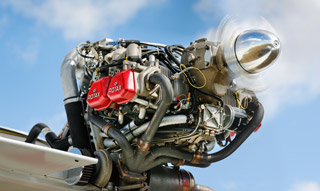
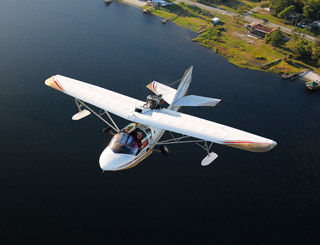
It wasn’t always true that the Searey would not stall. A check of accidents in the AOPA Air Safety Institute accident database over the past decade shows seven fatal Searey accidents, and some of them involved a stall followed by a spin—but that was an older design. The wings and tail were redesigned three years ago for the Searey LSX, an Experimental-category kit model. That design is now used on all models. A test pilot used all of his tricks to force the LSX model to spin, but got only one turn before it resumed flying. Woods got only half a turn before the aircraft recovered from the “spin” and began flying again in a spiral. Stalls, she said, are barely noticeable. Another dealer, Jim Ratte at Valkaria Airport in Malabar, Florida, said the wing will not drop during a stall. It mushes straight ahead, dropping at 1,000 feet per minute, Searey designer Kerry Richter said.
“We’ve never had an accident because of a structural failure in the last 20 years,” Progressive Aerodyne CEO Yang noted.
Transition training, as is the case for all Light Sport aircraft, is especially important in the Searey since it has low mass and high drag, Woods said. There are important differences from what pilots have experienced in other aircraft. Add lots of power and the nose drops slightly. Retard power and the nose comes back up. Those differences are quite subtle, since I barely noticed them while in formation.
Be ready for the aircraft to float a little in ground effect—call it water effect—before it settles. While it is a tailwheel aircraft, and requires a tailwheel endorsement for pilots familiar only with nosewheel aircraft, it is a particularly gentle taildragger, Woods said. The tailwheel is steerable. “You barely notice it is a taildragger,” she said.
Speed is simply not valued in the seaplane world, nor is altitude. It was surprising how quickly after takeoff I could adapt to stopping the climb before 1,000 feet, traveling slightly faster than the traffic below, and flying with the canopy pulled open a few inches. (Up to 90 mph you can have the canopy halfway open.) Waves on Lake Jackson at Sebring a day before the U.S. Sport Aviation Expo were less than the one-foot limit suggested in the pilot operating handbook. It can land in higher waves with an experienced pilot, Richter said.
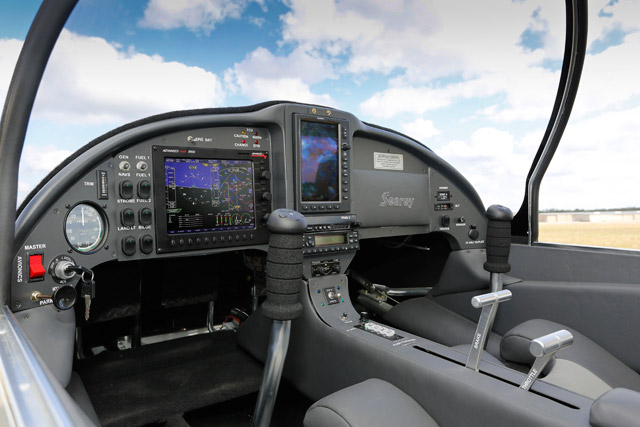
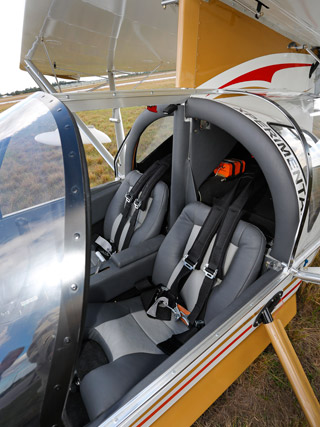
Construction of the Sport model includes a fiberglas hull on an aluminum frame with fabric-covered wings, tail, and control surfaces (the wing has a sheet-metal leading edge). The Elite model is the same except for the carbon fiber hull. The Rotax is way up there atop the cabin on a pylon. The more-powerful Elite will come standard with an engine cowling, while it is an option on the Sport. Seeing all the structure beneath the wing—including struts, braces, and floats—reminded me of an Erector Set. Each float has two frangible points that are intended to break in case of excessive side loading, such as a hard turn during a fast taxi. If the frangible attachments break, they allow the Lotus float to swing freely beneath the wing rather than transfer energy to the wing strut and cause damage.
Bolts, bolts, and more bolts mark the preflight. There are many to check, only because they are visible from outside the airframe. Ratte, the dealer at Recreational Mobility in Malabar, said this is an advantage. “Think of all you don’t see in most airplanes, where all of that is inside the airframe,” Ratte said. Because so much of the structure is exposed, an annual inspection takes only five hours, he added. One unusual aspect of the preflight has the pilot reaching behind the pilot seat to squeeze a rubber bulb in the fuel line while standing outside the airplane with a fuel drain cup. The drain is outside behind the cabin.
Wires link the tail to the wings. Richter said the purpose of the cables is to help keep the wing perpendicular to the fuselage and provide additional support during times of heavy structural loads, such as water operations. The tailwheel is held down by cable tension, and retracts when the tension is released. Wheels operate electrically, since it would be difficult with a manual system to force two large, fully inflated tires into the water.
In addition to engine and hull material differences, the Sport and Elite models have different avionics. The Sport model uses a Garmin aera 500 GPS with a 4.3-inch display, while the Elite has a Garmin GPSMap 696 with its seven-inch display. Both have Garmin GTX 327 transponders as standard equipment, along with a PS Engineering PAR100EX radio and an intercom system. The Elite also comes standard with an Advanced Flight Systems 5500 electronic flight instrument and engine management system with synthetic vision, plus docking or taxi lights and a cabin heater. In both aircraft, small LED lights above the pilots’ heads project beams towards the instrument panel.
You can still ignore the new factory-built Searey and buy a kit as in years past, but don’t ask me to help. I am still trying to get the toilet flappers in my townhouse to work correctly.
Email [email protected].
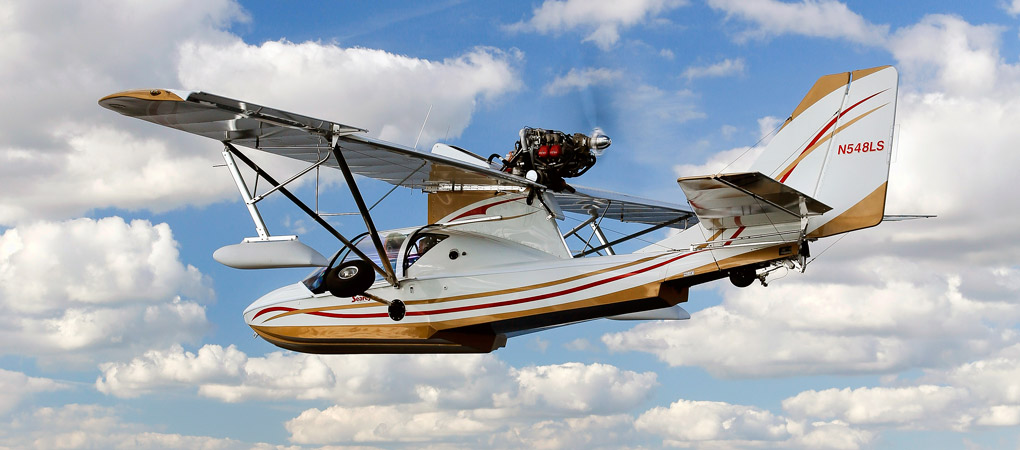
SPEC SHEET
Searey LSA Elite
- Base price: $125,000
- Price as tested: $144,900
Specifications
- Powerplant | 115 hp Rotax 914
- Recommended TBO | 2,000 hr
- Propeller | 3 blade 68 in dia Warp Drive
- Hull draft | 10 in
- Length | 22 ft 5 in
- Height | 6 ft 5 in
- Wingspan | 30 ft 10 in
- Wing area | 157 sq ft
- Seats | 2
- Cabin width | 3 ft 10 in
- Cabin height | 39 in
- Empty weight | 980 lb w/carbon fiber hull
- Empty weight, as tested | 993 lb
- Useful load | 450 lb
- Useful load, as tested | 450 lb
- Payload w/full fuel | 306 lb
- Payload w/full fuel, as tested | 293 lb
- Max takeoff weight | 1,430 lb
- Max landing weight | 1,430 lb
- Fuel capacity, std | 26 gal (24 gal usable) | 156 lb (144 lb usable)
- Baggage capacity | 50 lb, 13 cu ft
Performance
- Takeoff distance, ground roll | 350 ft
- Water takeoff distance | 550 ft
- Takeoff distance over 50-ft obstacle | 900 ft
- Max demonstrated crosswind component | 13 kt
- Rate of climb, sea level | 825 fpm
- Max level speed, sea level | 100 mph
- Cruise speed/range w/30-min rsv, std fuel
(fuel consumption) 1,000 ft
@ 75% power, best economy | 88 mph/362 statute miles (32 pph/5.3 gph) - Service ceiling | 13,500 ft
- Landing distance over 50-ft obstacle | 833 ft
- Landing distance, ground roll | 325 ft, water | 350 ft
Limiting and Recommended Airspeeds
- VX (best angle of climb) | 58 mph
- VY (best rate of climb) | 63 mph
- VA (design maneuvering) | 94 mph
- VFE (max flap extended) | 80 mph
- VLE (max gear extended) | 94 mph
- VLO (max gear operating)
Extend | 70 mph
Retract | 70 mph - VNO (max structural cruising) | 94 mph
- VNE (never exceed) | 120 mph
- VR (rotation) | 50 mph
- VS1 (stall, clean) | 47 mph
- VSO (stall, in landing configuration) | 40 mph
For more information
Contact Progressive Aerodyne, 3801 S.R. 19, Tavares, Florida 32778; telephone 352-253-0108 or 352-250-4624; email [email protected].
All specifications are based on manufacturer’s calculations. All performance figures are based on standard day, standard atmosphere, sea level, gross weight conditions unless otherwise noted.
Extra
Payload obviously can be increased by leaving off fuel, since most of your flights will not need the full Searey range of 362 statute miles, or the full endurance of four hours.



